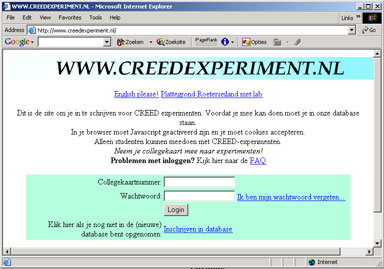
Handbook for CREED experiments
Tips, hints and internal rules
Joep Sonnemans
|
CREED Procedures and Rules
CREED is a professional organization. Although we have many experimenters, each with their own pecularities, our participants perceive CREED as a distinct "trademark". Therefore standarization is important. There are some strict rules and some standard procedures. You can deviate form standard procedures, if you have a good reason to do so, but the strict rules have to be observed. Strict rules
Standard procedures
|
[ Overview] [ Design] [ Computer programs] [ Financials] [ Internal CREED seminar] [ Reservation lab] [ Instructions] [ Questionnaires] [ Scenario] [ Pilots] [ Recruiting] [ Receipts] [ Logbook] [ Problems] [ Afterwards]
New! Sander Onderstal's "An experiment in 40 steps". It was written for a specific experiment but may be useful to others.
Overview
You have a nice idea for an experiment. You want answers on an important research question and you think running experiments is the best way to answer these questions. So you design an experiment. You decide what treatments you need. If you use computers, you have to program yourself, or ask our programmer to do this for you. Then you make an estimate of the budget you need. If it turns out that you need a lot of money, it may be wise to start with fewer and the most interesting conditions. When the design is (more or less) finished and you tell your colleagues about your plans in an internal CREED seminar. Suggestions in this seminar may lead to changes in your design. You ask an experiment number and make a lab reservation with the CREED Experiment Coordinator (Joep). You test (again) your software and you write instructions, questionnaires and a scenario. Probably you want to do a pilot to test your parameters. When you are sure about everything (especially the software) you start recruiting participants and you reserve the cash. At the day of the first session you will work according to the scenario you have made. Every session you fill in the laboratory logbook. Possibly you will encounter problems during your experiment. After the last session you return the signed receipts and the cash not spent to the responsible CFO (CREED Financial Officer: Karin). After the experiment you can start analyzing the data and writing the paper the world is waiting for. It is a good idea to make a copy of the raw data in a way that is understandable to outsiders, and put it on the internet, when your paper is accepted.Design of experiment
Designing an experiment starts with formulating the (main) research question. While working on your design, always ask yourself: "Is this design really the best way to answer this question?".
There are some important boundary conditions for your design. Deception of participants is forbidden in the CREED lab because of the negative external effects on other experiments. In fact, for all other elements of your design that may have negative externalities, contact CREED seniors.
Most common problems:
Computer programs
You can make your own program or ask our programmer (Jos). If you plan to do a lot of experiments in the future, programming yourself can be a very good investment.
If you program yourself, thare are many possibilities. Most used are:
Asking Jos Theelen to make the program
If you ask the programmer you have to fit into his planning. The
programmer can only start if you have very clear ideas about your
design. You have to explain the order of events in the experiment, you
have to draw pictures of the computer screens (what information is seen
by the participant) and you have to specify the output. Changing the
design after the programming has started is a waste of time and effort
and the programmer (rightly) will hate you for that.
The most critical part of software development is testing. The experimenter is responsible for testing the software. If there is a software failure during the experiment, the experimenter is to blame for not testing well enough. Testing should be done systematically: all conditions (parameters), appropriate number of participants logged in, appropriate number of periods. Test also whether the output file is correct! It is advisable to have a restart-option in order to relogin after a hard ware failure (or a participant who turns of the computer...).
If you need a (small) change in the program because referees asked for additional treatments and you would like to do this on short term, don't try to sneak to the front of the waiting list, but ask the programmer who is standing in the waiting list and try to convince these colleagues that it is important that you will be helped first.
Most common problems:
Financials
 Karin, the CREED Financial Officer
Karin, the CREED Financial Officer
Payment of the participants consist of a show up fee and the money they can earn during the experiment. In most cases the show up fee is 7 euros. However, if they can earn a large amount during the experiment, you may consider a smaller show up fee or no show up fee (but the participants that are sent away will receive 7 euros).
If more participants show up than you need, you have to send away participants with 7 euros each (first ask for volunteers. Determine random who has to leave if there are not sufficient volunteers.)
Because the behavior of the participants is not known before the experiment (of course, that is why you want to run the experiment) you cannot exactly determine the average earnings. Based upon theoretical predictions and experience you can make an estimate of the average earnings. Average earnings should be approximately 10 euros per hour (including show up fee). Short experiments pay a little better (to compensate for the effort to come to the lab). Experiments where you expect large differences between earnings should also pay a relatively high average (to make the lowly paid participants not too unhappy to participate again in CREED experiments).
We have to work for every euro we spend on participants. If you find out you need a lot of money, you may consider using less participants by cutting conditions (has also other advantages) or for example using a smaller group size.
At least three weeks before you need the money, you have to tell the CFO (CREED Financial Officer, Karin) because it takes some time to get the cash from the bank. You also need your OEN (Official Experiment Number). The day of the first session (or the day before that) you will have to sign for the cash you get. The form you sign is an excel-file, you will get an electronic copy on which (after the experiment) you fill in the cash you return, and the amounts on the receipts you hand in.
Internal CREED seminar
In the internal CREED seminar you explain the background of your experiment, you present the research question(s) and you explain your design. It may be helpful if you also specify any problematic decisions you had to make designing your experiment. You can also show the program (if available) and use this as a (limited) pilot. If the experiment is complicated, it can be helpful to show the experiment first and explain the background, design etc afterwards.
Some CREED staff members make their best remarks while sitting behind a pint of beer. Going to Krater afterwards and talk a little more about the experiment can be a good investment.
Most common problems:
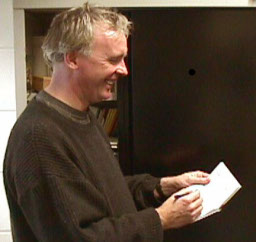 Joep makes a reservation
Joep makes a reservation
Reservation lab and Official Experiment Number
After you have presented an internal CREED seminar and you are confident you can run the experiment within a few weeks, you make a reservation for the lab with the Experiment Coordinator (Joep). Karin can provide you with an OEN (Official Experiment Number), to be used on recruitment forms and receipts.
Scenario
Running an experiment is not difficult, but there are a lot of things you have to think of, and you want every session to be an exact replication of the other sessions. Therefore you need a scenario. A scenario is a complete description of all procedure. Typically it starts with all the things you have to do before the start of a session (including software), what to do if too many or too few participants show up, what to say in the reception room, what to do and say during the experiment, what to answer to specific questions, etc. Download an example of a scenario (word file in Dutch).
Instructions
Most computerized experiments have instructions on screen. One of the nice things of instructions on screen is that you can interactively check for understanding. Multiple choice questions focus the participants on specific (important) parts of the instructions, but are not that good for checking understanding (everybody can answer a MC question after some tries). Therefore also use open form questions, for example where you ask the participant to look up things in a table.
Even if you have instructions on screen, you will also need a summary on paper. Try to fit this on one page (with additional tables if necessarily).
It is hard for the designer of an experiment to judge the clarity of instructions. Ask colleagues or naive friends to read and comment.
Questionnaires
In some experiments questionnaires are essential (for example if the research question is about experienced emotions) and in some it is only an easy way to get extra information. Making a good questionnaire can cost a lot of time and effort. In psychology it takes months or years to produce and validate a questionnaire and you are overly optimistic if you think you can do it from scratch in an afternoon. Look around, ask, borrow or steal if you are not prepared to spend a lot of time.
In my opinion the use of a questionnaire at the end of the experiment is always a good idea. It cannot influence the decisions because it is after the experiment and it costs no or only a little time (after the last decisions of the experiment you have to produce the receipts anyhow, you can do that while the participants fill in the questionnaires). The benefits can be enormous, especially if the behavior in the experiment is against your intuition. In that situation, the questionnaire can give ideas about what was really going on.
It is a good idea to use both open and closed questions. Some researchers dislike open questions, because answers can be hard to interpret and coding can cost a lot of time. However, there is a conventional wisdom that the inclusion of open questions improves the reliability of the closed questions and can be worthwhile even if you decide not to code them. The reason is that a respondent who feels he doesn't get the chance to give his opinion can be irritated and badly motivated to fill in the questionnaire. They can always loose their egg (?) in open questions like "Can you tell me about your reasoning during the decision making?". Furthermore, although the answers to the open questions are not easily reported in the paper, it can help you to understand any strange behavior or misunderstanding.
Download an example of a questionnaire (word file in Dutch):
Pilots
Pilot with colleagues
If you want to know whether the instructions, screens etc are easy to understand, you can ask colleagues in a pilot.
Pilot with student subjects
Sometimes a pilot experiment with paid participants is needed if you
are unsure about specific parameters. For example, if you have no idea
about teh number of periods you can play within 2 hours, or you need a
baseline condition without floor or ceiling effects (so the behavior in
the experimental conditions can be more extreme in both directions), a
pilot is a good idea. If you are only a little unsure, you can plan
your first session on Friday. If things go as you expected, you
continue with the other sessions as planned, if not, you change your
design over the weekend and consider the Friday session as a pilot.
Recruiting
Nowadays we use www.creedexepriment.nl. If you don't have a password to login in creedexperiment or forgot your password, ask Joep.
Safety
+Experimenters can only login from the uva-network
+The experimenters login is from a subdirectory (makes it a little harder for hackers to find the login page)
+Experimenter password is encrypted (if someone hacks the database the password is still secret)
-All experimenters can change experiments and sessions. It is possible
to adapt the sytem that only the person who defined an experiment can
do this, but this is impractical because most experiments are done by
more than one experimenter.
+Subjects need password
-Subject password is not encrypted (otherwise the emailsystem of forgotten passwords couldn't be used)
Standard receipts
To make live easier we have standarized the receipts. Download the file and change the experiment number, dates, names, etc. It is important to use the standard receipts, have all signatures of the participants. Never change the amount of the receipt! If you make a mistake writing the numbers, take a new receipt and let that sign by the participant. Download standard receipts (this is a word file, press the right mouse button to download the file).Logbook
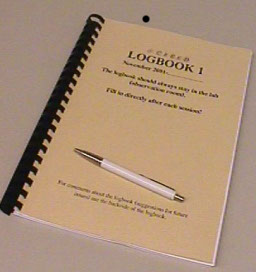 <= The old and the new version =>
<= The old and the new version =>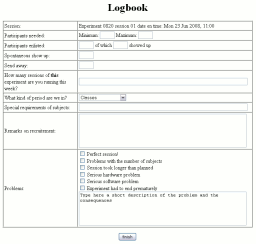
After the experiment
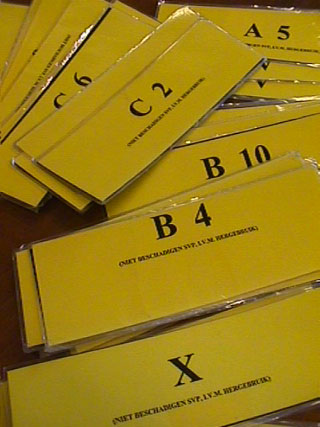 The tablenumbers to randomize subjects over tables. The "X" means that the subject cannot participate.
The tablenumbers to randomize subjects over tables. The "X" means that the subject cannot participate.